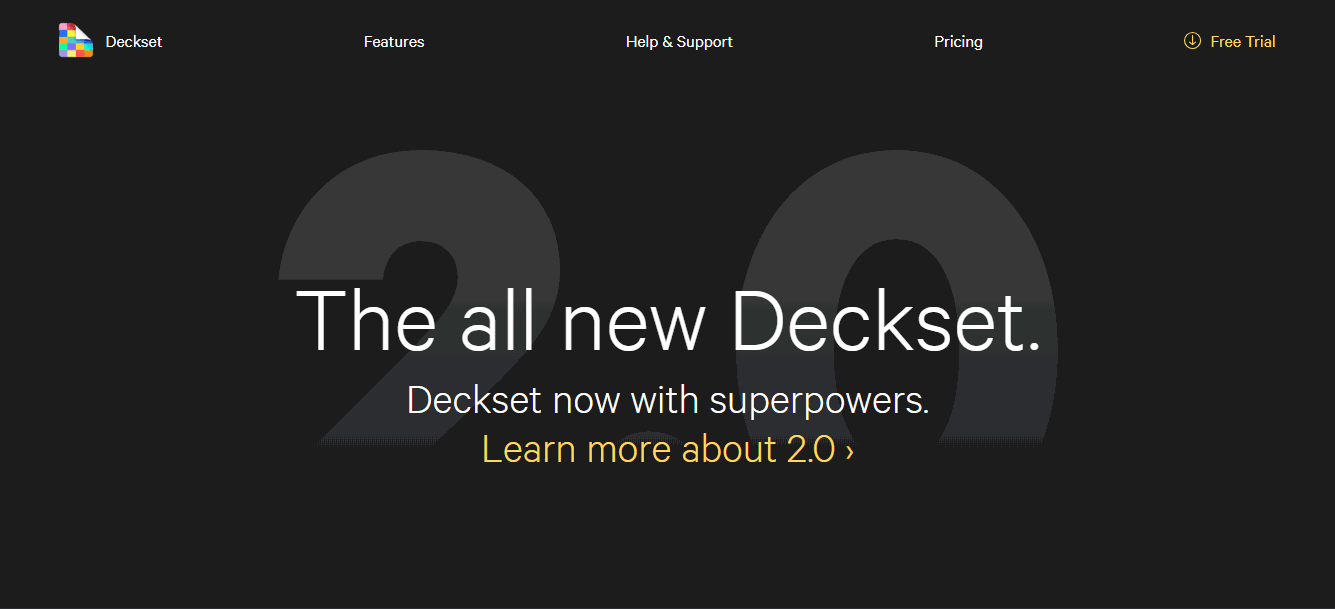
Other features that can be configured directly in your Markdown file are footers, basic slide build steps, and the ability to hide slides by commenting them out.

I had to manually set a timer on my phone when presenting, which was another thing to think about. This mode also shows a clock, but not a timer. The app supports presenter notes, add again through your Markdown file, and will show those alongside the current and next slide in a dedicated second-screen presenter view. Those familiar with Keynote will find any features they’re looking for in the first place they look, which is pretty much the pinnacle of good interface design. The application interface feels very at home on macOS, and is clearly designed specifically for the platform. In use, Deckset 2 is fast, clear, and very polished. Low enough stakes that I could retreat to Keynote if it all went wrong, but a real enough example that I’d be forced to actually use it in anger. To put Deckset 2 through its paces, I decided to use it to put together slides for a 10 minute lightning talk I was due to give at my local JavaScript meet-up. If this functionality does exist somewhere, that’s great, but the interface doesn’t readily offer it up. This is a slow process if you want to try out a few options. If you want to change all instances of the theme’s font, for example, it appears that you need to add a custom style for each different use of text and set the font. The only aspect to this approach that I didn’t get along with was the inability to change any sort of ‘global’ values for the theme. That would then enable you to open the same presentation, in the same state, on another computer. Themes exist as a feature of the application, not of the presentation, so if you customise a theme you’d do well to export it and same the theme file alongside your Markdown file. Want a different heading font? Add a “Header” custom style and set the font, size and colours there. This is accomplished by duplicating one of the in-built themes and then adding Custom Styles to overwrite various aspects. For the first time with Deckset, the user has control over fonts and colours. The big headline feature is the ability to customise the theme of the slides. Evolutionĭeckset 2 looks to try to tackle these shortcomings and introduces some key new features to help lift it out of the meeting room and into the keynote room. Great for a lightning talk at a local tech meet-up. This is fine for an internal presentation to colleagues. It helps you create slides quickly, ideally giving you more time to focus on the content itself. Its approach was, and still is, that of a productivity tool rather than a creative tool. If you wanted to pick your own fonts and colours, you were out of luck.ĭeckset had bags of functionality, but all of it was aimed at producing something fast rather than polished.

These could get you up and running with a reasonable looking presentation, and you could flip between preset colour schemes in a few themes, but the customisation ended there. The app came with a limited number of set themes - much like the default templates in Powerpoint and Keynote. It offered some configuration options for each slide, enabling the positioning of images and rough sizing of headings, but fell short of any further customisation. This initial version showed lots of promise, and certainly delivered on its promise to easily build slides from Markdown.
#Deckset presentation mac#
The original Deckset offered something new to the space - a Mac desktop app that offered a blend between the convenience of building slides based on Markdown and the reliability of presented directly from a desktop application. This is an arrangement that can certainly work, but one that brings a number of compromises for those used to presenting using familiar desktop tools such as Powerpoint and Keynote. The are already a number of good tools that will create a presentation from Markdown content, but these are predominantly web-based, requiring the presenter to use a web browser in full-screen mode to deliver their presentations. How much time could be saved laboriously producing slides if they could be automatically generated from my outline? As such, the concept of a presentation tool that builds a deck based directly on a Markdown file always sounded appealing to me. I do a lot of my writing in Markdown format, including structuring presentation outlines that way before I start building my slides. If you’re the sort of person who will use the arrow keys to finely nudge elements around a slide, then Deckset is probably not for you.


 0 kommentar(er)
0 kommentar(er)
